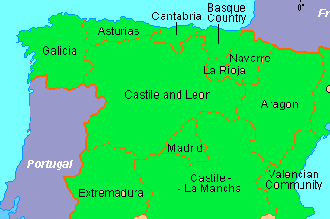The history and geography of Asturias (in brief)
Today visitors to this beautiful part of northern Spain can still see relics of Asturias' ancient civilizations in the form of cave paintings and megaliths. Evidence of the Asturians' ever advancing societies exist from the Celtic era through to the bronze and medieval ages, but it was with the occupation of the Romans that the first written records of the region were established.
Unlike many other parts of Spain, Asturias has suffered few occupations throughout the ages
 and significantly the invasion of the Moors was never truly successful in this province. Even so, the kingdom of Asturias was briefly consumed by adjacent neighbour Leon, but was re-established again by the fourteenth century.
and significantly the invasion of the Moors was never truly successful in this province. Even so, the kingdom of Asturias was briefly consumed by adjacent neighbour Leon, but was re-established again by the fourteenth century.
Historically Asturias has always been a home to the Christian faith and, even when Spain was under attack from the infidels, it was this small portion of the country where the native religion survived and prospered without persecution. Many churches and monasteries still populate this largely rural area and many are fine examplesof the provinces architectural heritage.
The industrial history of Asturias
Commercially and industrially Asturias has much in common with Galicia and a strong fishing heritage is present. But Asturias was also important during the time of the industrial revolution when it was a source of coal and iron. It was during this period that a number of powerful families made both their names and fortunes.
Throughout the 20th century the region was a major and economically important producer of steel with an international reputation and production level.
Like many other regions in northern Spain, Asturias saw large scale emigration to other parts of the world and particularly the Americas. Many of these immigrants made their fortunes and returned to the province in later life.
More recently, Asturias was a player in the Spanish civil war with the largely manual workforce of the region forming a strong socialist alliance. With the ultimate victory of Franco's fascists, this did not bode well for the region and it lost both its name and identity until democracy was restored after Franco's death in the nineteenth century.
A key moment in the region's modern history
In 1982 Asturias became one of Spain's 17 autonomous communities and now enjoys significant political control within its borders.
Geographically Asturias has a character that is very different to that of many other parts of Spain. Aside from its mild climate, the region has a roving coastline with many beaches, most of which feature cliffs as a backdrop. The scenery is predominantly green and rainfall is relatively high resulting in forests, running rivers and an environment suited to agriculture.

